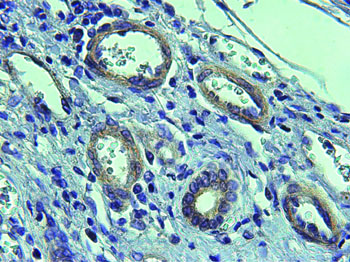Cytoplasmic Polyadenylation Element-Binding Proteins Regulate Pathologic Angiogenesis in Chronic Liver Diseas
|
By LabMedica International staff writers Posted on 03 Jan 2016 |

Image: Pathological blood vessels (white circles) have abundant CPEB4 expression in cirrhotic tissue (Photo courtesy of the Institute for Research in Biomedicine Barcelona).
A team of molecular biologists has identified a pathway that regulates the pathologic expression of VEGF (vascular endothelial growth factor), the main effector protein in the development of blood vessels, and angiogenesis in chronic liver disease.
VEGF regulates angiogenesis, yet therapeutic strategies to disrupt VEGF signaling can interfere with necessary physiologic angiogenesis. In a search for ways to inhibit pathologic production or activities of VEGF without affecting its normal production or functions, investigators at the Institute for Research in Biomedicine (Barcelona, Spain), studied the post-transcriptional regulation of VEGF by the cytoplasmic polyadenylation element-binding proteins CPEB1 and CPEB4 during development of portal hypertension and liver disease.
The investigators worked with liver biopsies from patients with HCV-associated cirrhosis or liver tissues removed during transplantation. They also performed experiments with male Sprague-Dawley rats and CPEB-deficient mice (C57BL6 or mixed C57BL6/129 background) and their wild-type littermates. Secondary biliary cirrhosis was induced in rats by bile duct ligation and portal hypertension was induced by partial portal vein ligation. Liver and mesenteric tissues were collected and analyzed in angiogenesis and reverse transcription PCR, and by a number of immunological tests and confocal microscopy assays. CPEB was knocked down with small interfering RNAs (siRNAs) in H5V endothelial cells, and translation of luciferase reporters constructs was assessed.
Results published in the November 25, 2015, online edition of the journal Gastroenterology revealed increased levels of CPEB1 and CPEB4 in cirrhotic liver tissues from patients, compared with control tissue, as well as in livers and mesenteries of rats and mice with cirrhosis or/and portal hypertension. Mice with liver-specific knockdown of CPEB1 or CPEB4 did not overexpress VEGF or have signs of mesenteric neovascularization, and developed less-severe forms of portal hypertension following portal vein ligation.
Regulation of CPEB4 by CPEB1 and the CPEB4 auto-amplification loop induced pathologic angiogenesis. Strategies to block the activities of CPEBs might be developed to treat chronic liver and other angiogenesis-dependent diseases.
"All current drugs that aim to prevent neovascularization are based on inhibiting VEGF or VEGF receptors, but the problem is that indiscriminate attack of this protein impairs the normal development of blood vessels, thus causing unbearable adverse effects," said Dr. Raul Méndez, research professor at the Institute for Research in Biomedicine. "The best about the study is that we demonstrate that the development of pathological blood vessels can be stopped by interfering with CPEB4 proteins while positive vascularization remains intact. The experiments in cells in vitro, in animal models, and in samples taken from patients with cirrhosis have revealed the molecular mechanisms through which the increase in CPEB4 favors the overexpression of VEGF in cirrhosis."
Related Links:
Institute for Research in Biomedicine
VEGF regulates angiogenesis, yet therapeutic strategies to disrupt VEGF signaling can interfere with necessary physiologic angiogenesis. In a search for ways to inhibit pathologic production or activities of VEGF without affecting its normal production or functions, investigators at the Institute for Research in Biomedicine (Barcelona, Spain), studied the post-transcriptional regulation of VEGF by the cytoplasmic polyadenylation element-binding proteins CPEB1 and CPEB4 during development of portal hypertension and liver disease.
The investigators worked with liver biopsies from patients with HCV-associated cirrhosis or liver tissues removed during transplantation. They also performed experiments with male Sprague-Dawley rats and CPEB-deficient mice (C57BL6 or mixed C57BL6/129 background) and their wild-type littermates. Secondary biliary cirrhosis was induced in rats by bile duct ligation and portal hypertension was induced by partial portal vein ligation. Liver and mesenteric tissues were collected and analyzed in angiogenesis and reverse transcription PCR, and by a number of immunological tests and confocal microscopy assays. CPEB was knocked down with small interfering RNAs (siRNAs) in H5V endothelial cells, and translation of luciferase reporters constructs was assessed.
Results published in the November 25, 2015, online edition of the journal Gastroenterology revealed increased levels of CPEB1 and CPEB4 in cirrhotic liver tissues from patients, compared with control tissue, as well as in livers and mesenteries of rats and mice with cirrhosis or/and portal hypertension. Mice with liver-specific knockdown of CPEB1 or CPEB4 did not overexpress VEGF or have signs of mesenteric neovascularization, and developed less-severe forms of portal hypertension following portal vein ligation.
Regulation of CPEB4 by CPEB1 and the CPEB4 auto-amplification loop induced pathologic angiogenesis. Strategies to block the activities of CPEBs might be developed to treat chronic liver and other angiogenesis-dependent diseases.
"All current drugs that aim to prevent neovascularization are based on inhibiting VEGF or VEGF receptors, but the problem is that indiscriminate attack of this protein impairs the normal development of blood vessels, thus causing unbearable adverse effects," said Dr. Raul Méndez, research professor at the Institute for Research in Biomedicine. "The best about the study is that we demonstrate that the development of pathological blood vessels can be stopped by interfering with CPEB4 proteins while positive vascularization remains intact. The experiments in cells in vitro, in animal models, and in samples taken from patients with cirrhosis have revealed the molecular mechanisms through which the increase in CPEB4 favors the overexpression of VEGF in cirrhosis."
Related Links:
Institute for Research in Biomedicine
Latest BioResearch News
- Genome Analysis Predicts Likelihood of Neurodisability in Oxygen-Deprived Newborns
- Gene Panel Predicts Disease Progession for Patients with B-cell Lymphoma
- New Method Simplifies Preparation of Tumor Genomic DNA Libraries
- New Tool Developed for Diagnosis of Chronic HBV Infection
- Panel of Genetic Loci Accurately Predicts Risk of Developing Gout
- Disrupted TGFB Signaling Linked to Increased Cancer-Related Bacteria
- Gene Fusion Protein Proposed as Prostate Cancer Biomarker
- NIV Test to Diagnose and Monitor Vascular Complications in Diabetes
- Semen Exosome MicroRNA Proves Biomarker for Prostate Cancer
- Genetic Loci Link Plasma Lipid Levels to CVD Risk
- Newly Identified Gene Network Aids in Early Diagnosis of Autism Spectrum Disorder
- Link Confirmed between Living in Poverty and Developing Diseases
- Genomic Study Identifies Kidney Disease Loci in Type I Diabetes Patients
- Liquid Biopsy More Effective for Analyzing Tumor Drug Resistance Mutations
- New Liquid Biopsy Assay Reveals Host-Pathogen Interactions
- Method Developed for Enriching Trophoblast Population in Samples
Channels
Clinical Chemistry
view channel
Compact Raman Imaging System Detects Subtle Tumor Signals
Accurate cancer diagnosis often depends on labor-intensive tissue staining and expert pathological review, which can delay results and limit access to rapid screening. These conventional methods also make... Read more
Noninvasive Blood-Glucose Monitoring to Replace Finger Pricks for Diabetics
People with diabetes often need to measure their blood glucose multiple times a day, most commonly through finger-prick blood tests or implanted sensors. These methods can be painful, inconvenient, and... Read moreMolecular Diagnostics
view channel
Urine Test Could Reveal Real Age and Life Span
Chronological age does not always reflect how quickly the body is aging, as biological age is shaped by genetics, stress, sleep, nutrition, and lifestyle factors such as smoking. A higher biological age... Read more
Genomic Test Identifies African Americans at Risk for Early Prostate Cancer Recurrence
Prostate cancer is one of the most commonly diagnosed cancers in men and a leading cause of cancer-related death, particularly in the United States. African American men face a disproportionately higher... Read moreHematology
view channel
MRD Tests Could Predict Survival in Leukemia Patients
Acute myeloid leukemia is an aggressive blood cancer that disrupts normal blood cell production and often relapses even after intensive treatment. Clinicians currently lack early, reliable markers to predict... Read more
Platelet Activity Blood Test in Middle Age Could Identify Early Alzheimer’s Risk
Early detection of Alzheimer’s disease remains one of the biggest unmet needs in neurology, particularly because the biological changes underlying the disorder begin decades before memory symptoms appear.... Read more
Microvesicles Measurement Could Detect Vascular Injury in Sickle Cell Disease Patients
Assessing disease severity in sickle cell disease (SCD) remains challenging, especially when trying to predict hemolysis, vascular injury, and risk of complications such as vaso-occlusive crises.... Read more
ADLM’s New Coagulation Testing Guidance to Improve Care for Patients on Blood Thinners
Direct oral anticoagulants (DOACs) are one of the most common types of blood thinners. Patients take them to prevent a host of complications that could arise from blood clotting, including stroke, deep... Read moreImmunology
view channel
Ultrasensitive Liquid Biopsy Demonstrates Efficacy in Predicting Immunotherapy Response
Immunotherapy has transformed cancer treatment, but only a small proportion of patients experience lasting benefit, with response rates often remaining between 10% and 20%. Clinicians currently lack reliable... Read more
Blood Test Could Identify Colon Cancer Patients to Benefit from NSAIDs
Colon cancer remains a major cause of cancer-related illness, with many patients facing relapse even after surgery and chemotherapy. Up to 40% of people with stage III disease experience recurrence, highlighting... Read moreMicrobiology
view channel
New UTI Diagnosis Method Delivers Antibiotic Resistance Results 24 Hours Earlier
Urinary tract infections affect around 152 million people every year, making them one of the most common bacterial infections worldwide. In routine medical practice, diagnosis often relies on rapid urine... Read more
Breakthroughs in Microbial Analysis to Enhance Disease Prediction
Microorganisms shape human health, ecosystems, and the planet’s climate, yet identifying them and understanding how they are related remains a major scientific challenge. Even with modern DNA sequencing,... Read morePathology
view channel
Genetics and AI Improve Diagnosis of Aortic Stenosis
Aortic stenosis is a progressive narrowing of the aortic valve that restricts blood flow from the heart and can be fatal if left untreated. There are currently no medical therapies that can prevent or... Read more
AI Tool Simultaneously Identifies Genetic Mutations and Disease Type
Interpreting genetic test results remains a major challenge in modern medicine, particularly for rare and complex diseases. While existing tools can indicate whether a genetic mutation is harmful, they... Read more
Rapid Low-Cost Tests Can Prevent Child Deaths from Contaminated Medicinal Syrups
Medicinal syrups contaminated with toxic chemicals have caused the deaths of hundreds of children worldwide, exposing a critical gap in how these products are tested before reaching patients.... Read more
Tumor Signals in Saliva and Blood Enable Non-Invasive Monitoring of Head and Neck Cancer
Head and neck cancers are among the most aggressive malignancies worldwide, with nearly 900,000 new cases diagnosed each year. Monitoring these cancers for recurrence or relapse typically relies on tissue... Read moreTechnology
view channel
Pioneering Blood Test Detects Lung Cancer Using Infrared Imaging
Detecting cancer early and tracking how it responds to treatment remains a major challenge, particularly when cancer cells are present in extremely low numbers in the bloodstream. Circulating tumor cells... Read more
AI Predicts Colorectal Cancer Survival Using Clinical and Molecular Features
Colorectal cancer is one of the most common and deadly cancers worldwide, and accurately predicting patient survival remains a major clinical challenge. Traditional prognostic tools often rely on either... Read moreIndustry
view channel
BD and Penn Institute Collaborate to Advance Immunotherapy through Flow Cytometry
BD (Becton, Dickinson and Company, Franklin Lakes, NJ, USA) has entered into a strategic collaboration with the Institute for Immunology and Immune Health (I3H, Philadelphia, PA, USA) at the University... Read more





















